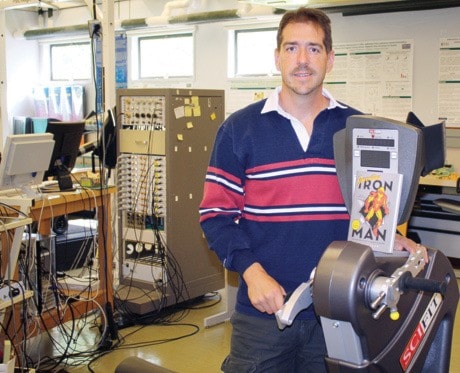By day, he studies new rehabilitation methods for stroke and spinal cord injury patients.
By night, he uses comic book superheroes to explore the outer limits of biological and technological development.
It’s not quite as dramatic a contrast as those of the characters he uses for inspiration, but E. Paul Zehr is living his own version of a double life, nonetheless.
A professor of neuroscience and kinesiology at the University of Victoria, Zehr is carving out a name for himself as an author of what he calls “speculative non-fiction.”
His second book, Inventing Iron Man: The Possibility of a Human Machine, was published this year by Johns Hopkins University Press. In it, Zehr examines whether it would be possible to create an armoured suit like the one worn by the titular superhero, and the consequences of creating one.
“In our brains, ever since we were developing in utero, this mapping has been occurring where sensory information from the skin of your body is helping to create this map of sensations in your brain that represents your body,” he explained.
“If you have a map that’s full already, and you jam an armoured suit on top of it, where does it go?”
To try to answer that question, Zehr looked at three main elements of the Iron Man suit: the amplification of strength it provides, its ability to fly and the physical protection it offers.
But beyond discussing the plausibility of such a suit, and the technology that would be necessary to build one, Inventing Iron Man goes deeper, looking at the physical and mental effects it could have on the wearer.
“If you’re in this suit that amplifies your abilities, it means you’re not actually using your body to move your body around,” Zehr said.
“You wind up having deconditioning, and reduced output, and reduced strength and reduced bone mineralization.”
And what about the mind?
“We’re thinking of it from the perspective of, ‘we’re connected to the device, so we can control it and do stuff.’ But the device is also connected to us, and that has some implications.”
Inventing Iron Man is Zehr’s second book. His first, Beyond Batman, looked at whether a person could realistically whip themselves into superhero shape à la Dark Knight.
Zehr said the pop culture icons are a perfect way to explore scientific concepts in an accessible way.
“When you try and talk about science with the general public, I like to choose things that everyone’s already familiar with,” he said. “If I say Iron Man to you, you have a mental image, we have the same common image and we can talk about the science.”
Not only that, writing has helped Zehr in his research at UVic.
“As a scientist, you have to reduce down, so you can answer questions yes or no. But we don’t often zoom it back out and say ‘What does that mean? How does it affect these things? What does it relate to this?’
“You have to do that to write a book.”
Whether a real-life Iron Man suit is indeed possible – Zehr thinks that it’s likely that there are some governments already working on some version – the author hopes the book opens people’s minds to some new concepts.
“I think we ought to be thinking about some of these things before we get to that point (that a suit is made). A little advanced thought would be helpful, I think.”
It’s not quite a superpower, at least in the comic book sense, but in a way, Zehr has found a way to look into the future.
editor@oakbaynews.com
